Contributory members are able to log private notes and comments about each site
Sites Anne T has logged. View this log as a table or view the most recent logs from everyone
Housesteads Mound
Trip No.43 Entry No.4 Date Added: 4th Sep 2017
Site Type: Misc. Earthwork
Country: England (Northumberland)
Visited: Yes on 2nd Sep 2017. My rating: Condition 2 Ambience 3 Access 4

Housesteads Mound submitted by Anne T on 4th Sep 2017. We didn't walk down to the mound, as we didn't have permission to be in the field, but it looks like a small tumulus to my untrained eye. There are no other features like this along this section of land running alongside the B6318 Military Road, at least within about half a kilometre either side, apart from another tumulus on Green Brae, near East Crindledykes.
(View photo, vote or add a comment)
Log Text: Housesteads Mound, near Housesteads Tumulus, Bardon Mill: This mound is marked on the OS map as a mound, and as we were in the field, walked to the change in slope where the ground dipped into a hollow. The mound was certainly popular with the sheep. Didn’t walk down to it, as it was a fair way across the field and it was getting late. I’d called it up on my mobile phone, and it didn’t seem hugely important.
Dead Friar's Stone (Stanhope)
Trip No.42 Entry No.2 Date Added: 31st Aug 2017
Site Type: Marker Stone
Country: England (County Durham)
Visited: Yes on 28th Aug 2017. My rating: Condition 3 Ambience 3 Access 5
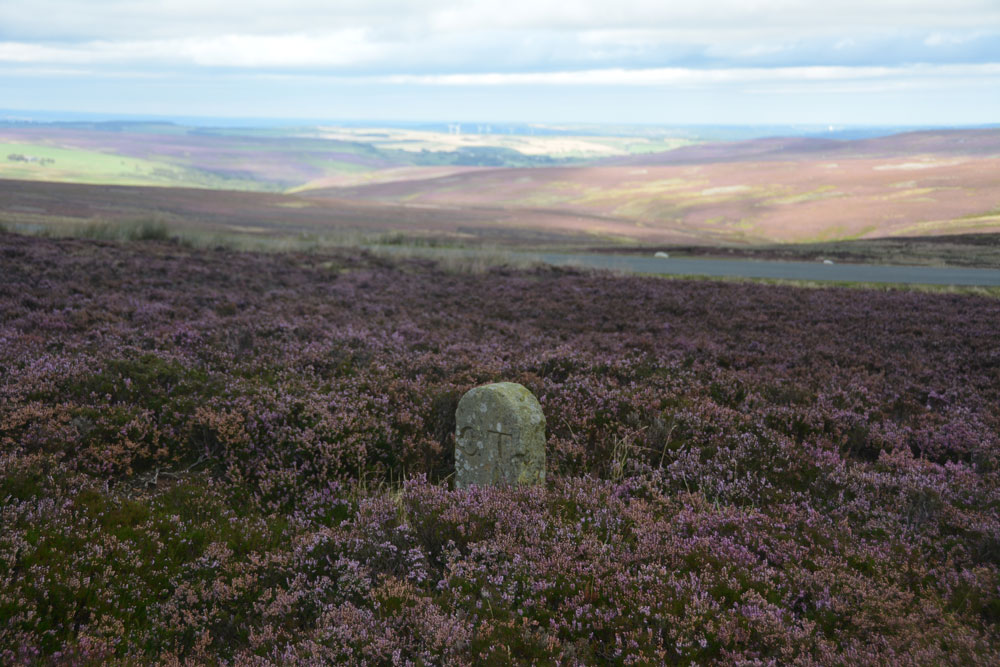
Dead Friar's Stone (Stanhope) submitted by Anne T on 31st Aug 2017. Standing at the edge of the parking area looking north east towards Edmundbyers.
(View photo, vote or add a comment)
Log Text: Dead Friar's Stone, Stanhope: From Old Man's Grave, just north of this stone, this was our second stop of the day - a curiously named stone next to Dead Friar’s quarry. Amusingly, husband thought a great slab of concrete lying next to the car park was the stone lying on its side! We looked again.
At a great viewpoint eastwards, although I thought this perhaps should have been a taller way marker rather than a boundary stone, given where it stands – at a bend of Meadows Edge (marked Dead Friar’s Road on the OS map), and where another smaller track heads off across the moorland westwards, then south, towards Rookhope.
The area around Rookhope always has ‘not very nice’ connotations for me, given my son-in-laws brother was killed in an accident green-laning on his trials bike just over 2 years ago, and I was glad to move on from this lonely spot.
Old Man's Grave (Edmunbyers)
Trip No.42 Entry No.1 Date Added: 30th Aug 2017
Site Type: Marker Stone
Country: England (County Durham)
Visited: Yes on 28th Aug 2017. My rating: Condition 3 Ambience 2 Access 4

Old Man's Grave (Edmunbyers) submitted by Anne T on 30th Aug 2017. First view of the stone, which sits between two footpaths on the parish boundary between Edmundbyers and Hunstanworth. Marked on the OS map, I wondered if the installation of the corner fence post had disturbed its location.
(View photo, vote or add a comment)
Log Text: Old Man's Grave, Meadows Edge Road, Near Blanchland: We originally intended to go to Blanchland to look at a holy well marked on the OS map, not far from the town square, but the village show was on and it was impossible to park. We drove on across to the moors, intended to stop at a boundary stone on the way to Old Man’s grave, but the roads were too busy to stop.
I was expecting a cairn, but this is a small, relatively modern boundary marker, sited between two footpaths, and at the corner of a modern fence.
Not impressed, but stopped to photograph it anyway. Certainly stunning views, and I’m guessing at some time in the past this might have been a cairn with a way marker on top, or by, especially with it being located just up the hill from where Bale Hill turns into Meadows Edge, and where two different trackways led off the north east and south west off Meadows Edge across the moorland.
Edmundbyers Cross (Muggleswick)
Trip No.42 Entry No.6 Date Added: 29th Aug 2017
Site Type: Ancient Cross
Country: England (Northumberland)
Visited: Yes on 28th Aug 2017. My rating: Condition 2 Ambience 3 Access 5
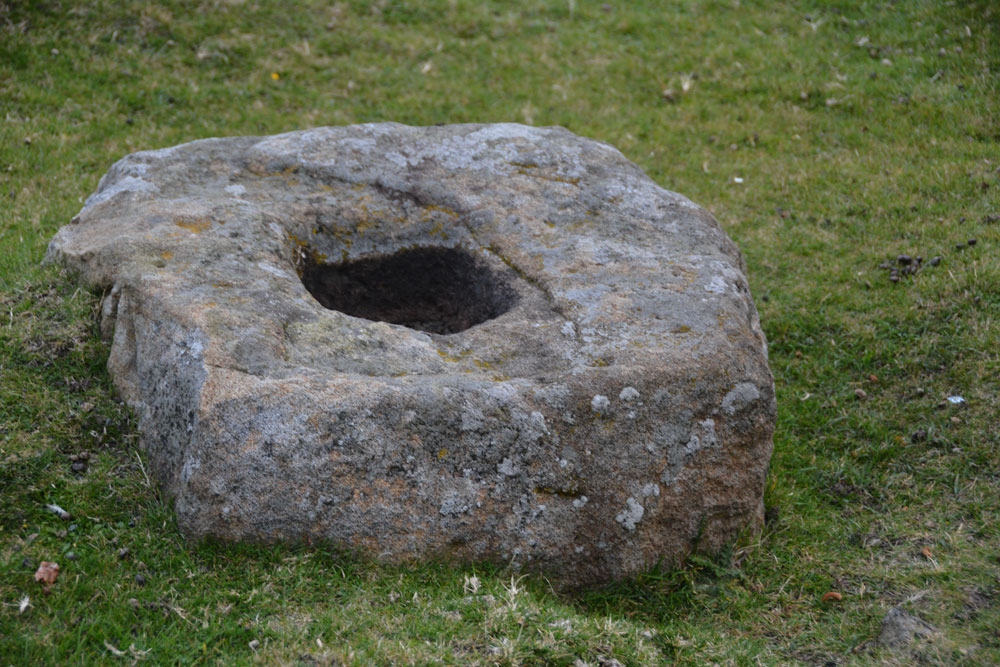
Edmundbyers Cross (Muggleswick) submitted by Anne T on 29th Aug 2017. Close up of the cross base, showing its socket hole.
(View photo, vote or add a comment)
Log Text: Remains of Edmundbyers Cross, Muggleswick: Marked in italic, old fashioned script on the OS map, I guess I was expecting something a little more exciting, such as a cross base with part of a shaft, but no. Just a cross base. Good job I knew what I was looking for as alongside the road there were other pieces of rectangular rock almost as large.
Sitting almost at the junction of the B6278 to Edmundbyers with the minor road leading almost to Smiddy Shaw Reservoir (just to the north of this road), it would have acted as a way marker. The cross base is located just over 1km from the boundary stone above.
When we got home, I was interested to read this from the Historic England entry: “Edmundbyers Cross is one of only three wayside crosses still in its original position in County Durham and the only known example on the route between Stanhope and Edmundbyers.”
Feldon Plain (Muggleswick)
Trip No.42 Entry No.5 Date Added: 29th Aug 2017
Site Type: Marker Stone
Country: England (Northumberland)
Visited: Yes on 28th Aug 2017. My rating: Condition 3 Ambience 3 Access 5

Feldon Plain (Muggleswick) submitted by Anne T on 29th Aug 2017. The stone (and sheep) as seen from the north east. There is a level mark almost at ground level, on the side facing the road. It certainly is in a lonely spot. It sits precisely on the parish boundary between Muggleswick and Hunstanwick (if I've read the map correctly) and also almost at the junction of two major routes across the moors.
(View photo, vote or add a comment)
Log Text: Marker Stone, junction of Meadows Edge & B6278: Despite quite an intensive search, I’ve not found any information on the internet (checked Pastscape, Historic England, National Geograph, etc).
Marked ‘BS’ on the OS map, this impressively large stone (in comparison to the others we saw on the way here) sits exactly on the Parish boundary between Muggleswick and Hunstanwick (if I’ve read the map correctly). Sitting right by the side of the B62787 to Edmundbyers, close to its junction with the Meadows Edge Road.
This is close to the remains of the Edmundbyers Cross Base, just to the north east, with Feldon Plain rising up gently behind it. It is a taller version of Hunstanworth North, again with the sloping top. It sits in a slight dip, as if the ground surface has built up around it, and there are a few packing stones visible at its base. Looks as if it has been here for a while.
Its shape echoes that of Hunstanworth Moor North, being long, thin & narrow with a sloping top.
Hunstanworth Moor north
Trip No.42 Entry No.4 Date Added: 29th Aug 2017
Site Type: Standing Stone (Menhir)
Country: England (County Durham)
Visited: Yes on 28th Aug 2017. My rating: Condition 3 Ambience 3 Access 5

Hunstanworth Moor north submitted by HarperFox on 20th Jul 2014. This is the northernmost of the two stones.
(View photo, vote or add a comment)
Log Text: Hunstanworth Moor North, Townhead: Being the day of the Blanchland and Hunstanworth Show, this road was very busy, and it was difficult to stop as the road was narrow and there were no obvious lay-bys or pull-off points (there being a nice ditch at the western side of the road and a steep bank up to the field on the east).
Spotted this stone as we were passing by on the way to the stone approx. 575m south and retraced our steps to photograph it.
Again, after having done searches on the internet, not been able to find out anything about it, like it’s ‘partner’ further up the hill.
Hunstanworth Moor south
Trip No.42 Entry No.3 Date Added: 29th Aug 2017
Site Type: Standing Stone (Menhir)
Country: England (County Durham)
Visited: Yes on 28th Aug 2017. My rating: Condition 3 Ambience 3 Access 5
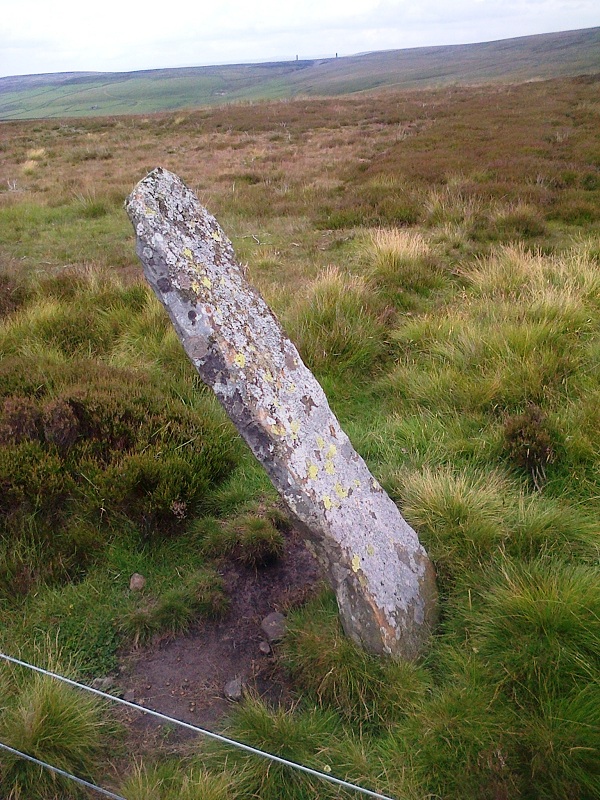
Hunstanworth Moor south submitted by HarperFox on 20th Jul 2014. This is the southernmost of the two roadside stones on the road between Townfield and Rookhope. The other is similar in shape and dimensions but upright.
(View photo, vote or add a comment)
Log Text: Hunstanworth Moor South, Near Townhead: This stone is marked on the OS Map as ‘stone’, and was easily found, although it seems like a tall boundary marker along the road from Townhead to Rookhope. As we drove along the road, we passed the northern boundary stone (see below), which isn’t marked on the map and was unexpected.
Haven’t been able to find out anything about these – not even a photograph on Geograph, as Andy Curtis has usually been out and about photographing all these places before us.
We backtracked to photograph the northern boundary stone on our way back to see the remains of the Edmundbyers Cross. I was impressed by all the now disused lead mining buildings and spoil heaps around here. It must have really busy in the not so distant past.
Ad Gefrin
Trip No.37 Entry No.9 Date Added: 28th Aug 2017
Site Type: Ancient Palace
Country: England (Northumberland)
Visited: Yes on 6th Aug 2017. My rating: Condition 1 Ambience 4 Access 5
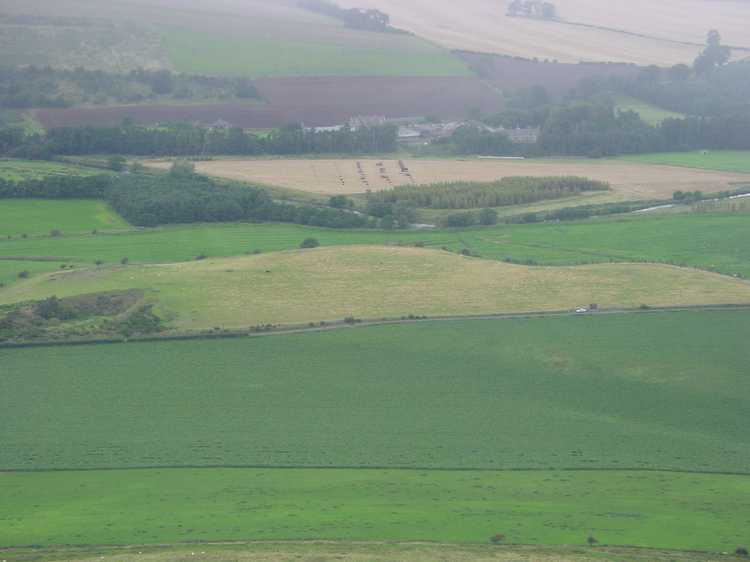
Ad Gefrin submitted by PaulH on 13th Mar 2003. Yeavering Bell hill fort
View of Ad Gefrin at NT926305
At the foot of Yeavering Bell is the site of probably the most impaces dating from the seventh century. The palace, Ad Gefrin, (the place of the goats) was one of the homes of King Edwin of Northumbria, whose name was given to another town - 'Edwin's Burgh', now known as Edinburgh.
It was at Ad Gefrin that St Paulinus baptised 3000 Northumbrians in 627 AD, just about twenty-five years prior to St Cuthbert's entry into Melrose Abbey.
(View photo, vote or add a comment)
Log Text: Ad Gefrin, Northumberland (near Yeavering): Trying to dry out from the walk to the Stob Stones, we decided to go back via Wooler and the A687 rather than back down the A68, passing Yeavering Bell on our way. Driving north, I was surprised to find we re-entered England from Scotland, back into Northumberland National Park. As we drove through Kirknewton, this ‘stone bus shelter’ and unusual gate posts caught my eye and we screeched to a halt.
I was amazed that we’d never heard of this site at all, and I read the interpretation board, then walked into the field to look at the other board. In front of me there was nothing but tall, yellow grass, with a faint darker green line where a narrow track ran along the edge of the field.
There was nothing on the interpretation board to tell us where about on the site we were. Seeing that the site spread across the road, I crossed and peered into the field. This, of course, now being England, I couldn’t just let myself into the field and wander around.
There being an excellent 4G signal here, I pulled up the Gefrin website and was really surprised to find this site described as the most evocative archaeological sites in Northumberland and also one of the most remarkable archaeological discoveries of the 20th century.
If I hadn’t been so wet and tired after a long day out, I’d have walked round the fields. As it was, we decided to return home, do some investigation and return to the site another day (adding to our ever growing list of ‘want to see’ sites).
St. Gregory's The Great (Kirknewton)
Trip No.41 Entry No.7 Date Added: 28th Aug 2017
Site Type: Sculptured Stone
Country: England (Northumberland)
Visited: Yes on 26th Aug 2017. My rating: Condition 3 Ambience 4 Access 5
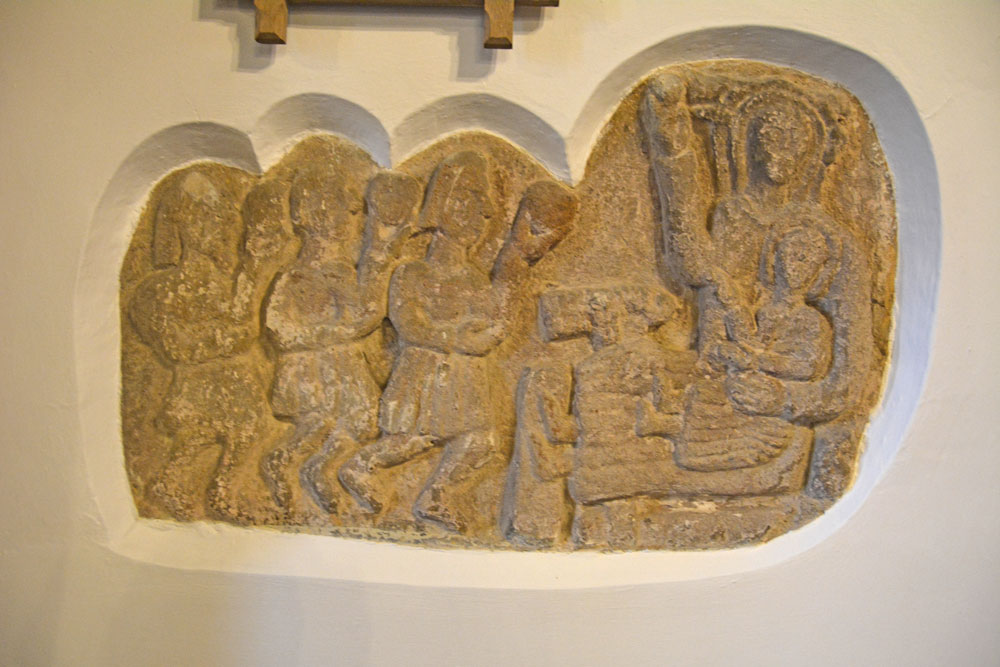
St. Gregory's The Great (Kirknewton) submitted by Anne T on 28th Aug 2017. The unusual Adoration of the Magi, with the Magi in what looks like kilts, but which are probably Roman tunics. Historic England says this dates from the 12th century, but the church thinks it might be several centuries earlier, pre-dating the church.
(View photo, vote or add a comment)
Log Text: The Adoration of the Magi (in Roman tunics): St. Gregory's The Great, Kirknewton: I confess to not being ready to go back home as it was such a nice evening, and this church looked very welcoming, so we stopped off for a look.
The main entrance to the church yard leads over a small, nicely landscaped stream. Immediately facing you to the left hand side of the path are some Commonwealth War Graves, very nicely tended, and all of air force pilots from 1943, mostly in their early 20s; one man was from Brazil. Inside the church there is a lovely sculpture and stained glass dedicated to these men.
There was no church guide to take away, but there were notices all over the church with explanations. There was a stone carving -The Adoration of the Magi, sited in the wall to the north side of the chancel.. The interpretation board near it reads: “The carving is quite amazing as it appear to show the Magi in kilts (but probably Roman tunics). The ancient stone relief is a great treasure of the church, being at least 12th century and could be earlier. There is some evidence to suggest that the style of the Magi “caps” is similar to an example in the Roman catacombs, so there could be the influence of St. Paulinus, himself a Roman (who supposedly preached at Kirknewton) and would date the carving at several centuries earlier, pre-dating the church (where was it prior to that?).”
The chancel and sanctuary look as if they have been fortified and used for defensive purposes (barrel vaulted ceiling and thick walls). I enjoyed walking round this church. It had a very friendly feel and was very well looked after.
Elsdonburn Shank Shielings (Kilham)
Trip No.41 Entry No.6 Date Added: 28th Aug 2017
Site Type: Ancient Village or Settlement
Country: England (Northumberland)
Visited: Yes on 26th Aug 2017. My rating: Condition 1 Ambience 3 Access 3
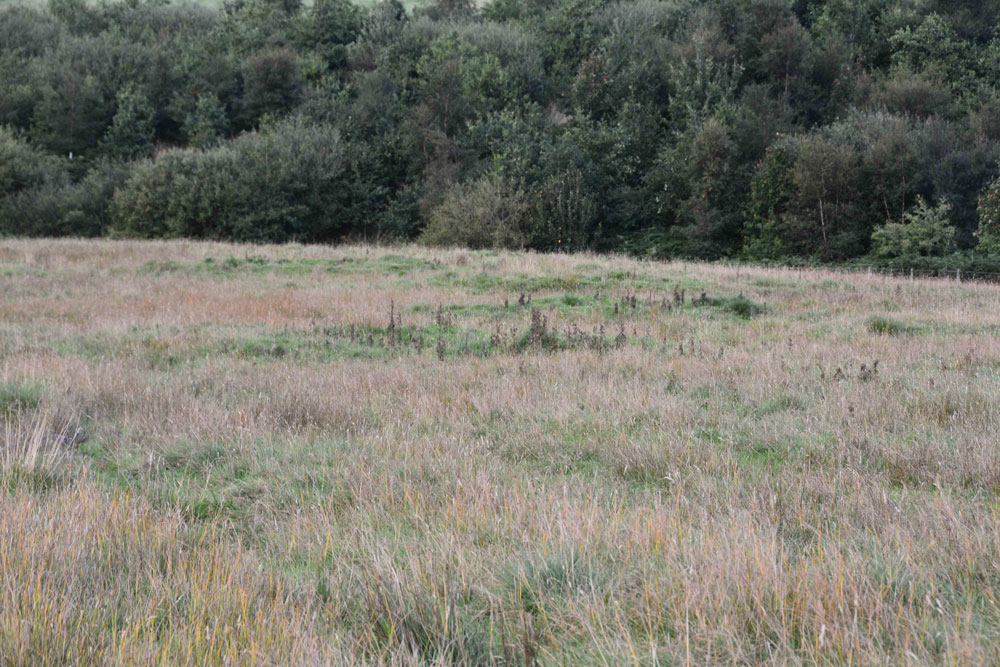
Elsdonburn Shank Shielings (Kilham) submitted by Anne T on 28th Aug 2017. Having walked by these shielings on the way up the hill, they were actually far more visible coming down the track from Elsdonburn Shank farm. The turf covered foundations, like Longknowe Settlement nearby, stood out as a darker green with lower growing grass, as opposed to the yellowing stems of taller grass around them.
(View photo, vote or add a comment)
Log Text: Elsdonburn Shank Shielings, Kilham: Husband had read somewhere that these might possibly have Saxon origins, although I’ve not been able to find the link.
Marked on the OS map as ‘old shielings’ we missed these on the walk up to Elsdonburn Shank as I was looking on the wrong side of the track. Actually, they were more visible on the way down, in the early evening light, with the very slight banks of the shielings a darker green and with lower growing grass on their surface. If I hadn’t been out with the archaeology group surveying shieldings, I would have passed these by.
We spent about 10 minutes here wandering around, trying to work out the shape of the structures. Not a huge amount so see, but another Pastscape site in the vicinity of Ring Chesters marked off.
Elsdonburn Shank (Kilham)
Trip No.41 Entry No.4 Date Added: 28th Aug 2017
Site Type: Ancient Village or Settlement
Country: England (Northumberland)
Visited: Yes on 26th Aug 2017. My rating: Condition 2 Ambience 4 Access 3
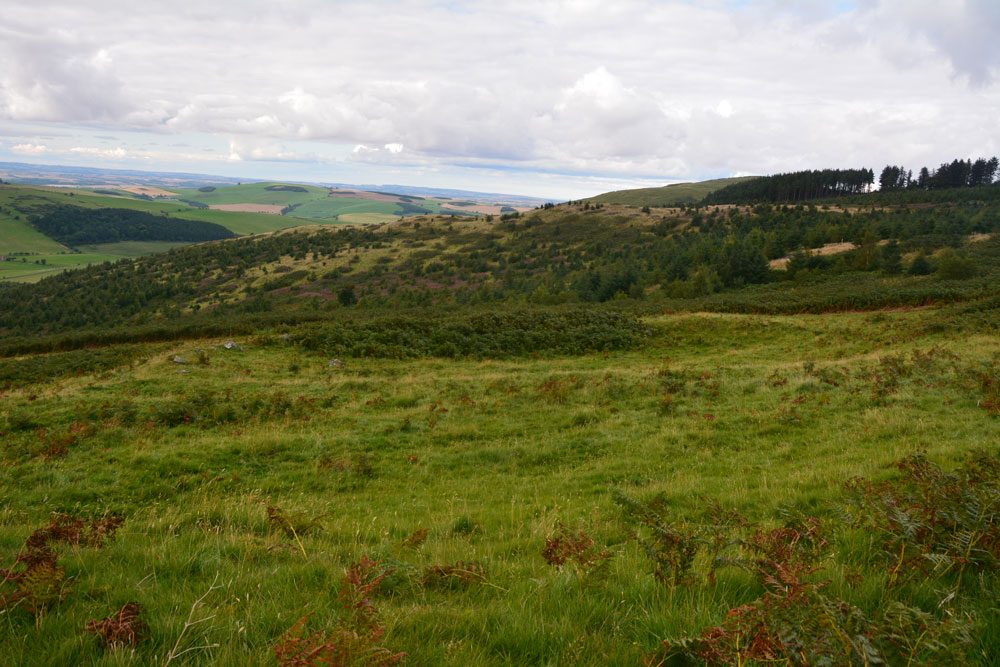
Elsdonburn Shank (Kilham) submitted by Anne T on 28th Aug 2017. Enclosure A from the northern-most part of the bank of Enclosure B.
(View photo, vote or add a comment)
Log Text: Elsdonburn Shank Villages, Kilham: Why are all the interesting sites up, up, up hill?? From Longknowe Settlement, we drove to Thompsons Walls and parked just behind their stack of sileage bales. The footpath continues here, and is metalled, but is a private road, so we decided not to drive any further.
It is a very pleasant walk along this road, with the hills looming around you on three sides. The ground looks very fertile here, and there were many, many sheep and their lambs on the green pasture. The farmer passed me with his large mower and gave a great wave. We later saw him mowing the grass in a meadow on the other side of the valley.
The footpath splits at the point where a burn tumbles down from a wood and goes underneath the road. We took the left hand fork which runs up to Elsdonburn Shank Farm, the house now deserted but the land and barn still used.
Just before the barn, the footpath dives off diagonally south east across the field, leading down to a gate just before the stream. It looks at first glance as if this stream is going to be wide, because the valley is quite deep, but when you get down to it, it’s just a little trickle, with a few stones placed across to make it easy to cross. From here, the footpath disappeared, and we ended up tracked north east up the hill, led by a string of large boulders which seemed (to us) to mark the track. In fact higher up, the footpath has been mown of bracken and leads along the fence line up the hill.
Just as I was getting tired of clambering up the slope, Village A came into view and we sat on the western side of the bank to have a drink before exploring. Well worth coming up here. Enclosure A was easier to decipher than B, which had much more bracken growing within it, and a tumble of stones peeking out of the grass.
With the dark skies getting darker, we plodded up the hill towards Ring Chesters.
Longknowe (Kilham)
Trip No.41 Entry No.3 Date Added: 28th Aug 2017
Site Type: Ancient Village or Settlement
Country: England (Northumberland)
Visited: Yes on 26th Aug 2017. My rating: Condition 2 Ambience 3 Access 5
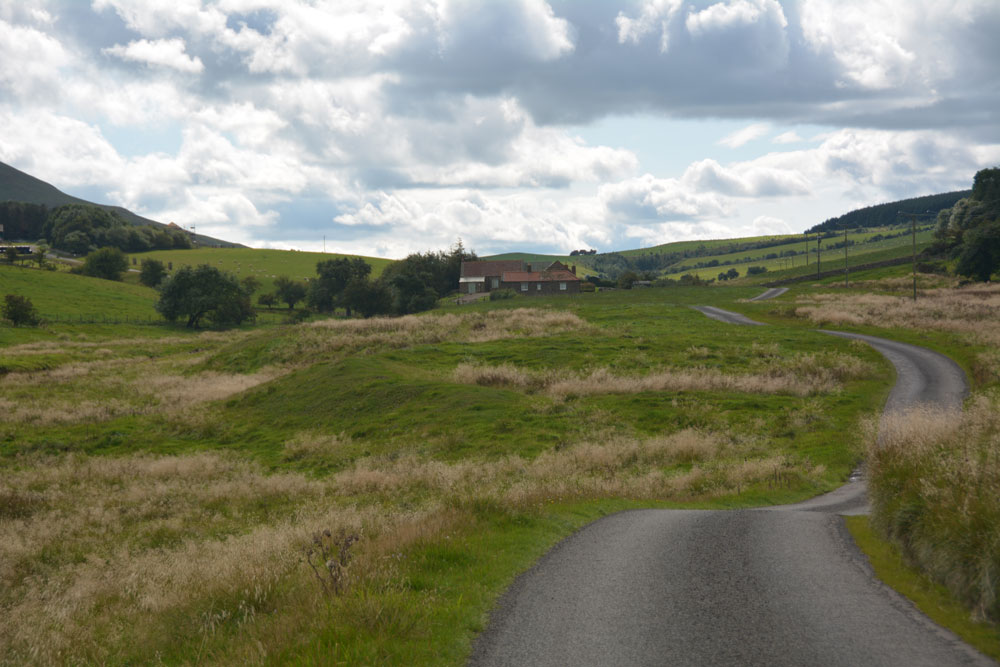
Longknowe (Kilham) submitted by Anne T on 28th Aug 2017. First view of the Longknowe settlement, approaching it from the minor road from Kilham to Longknowe and Thompsons Walls farms.
(View photo, vote or add a comment)
Log Text: Longknowe Settlement, Kilham: Our first scheduled stop of the day, having been diverted by two very interesting standing stones!
Driving down the single track road towards Longknowe Farm and Thompsons Walls, it was a bit tricky to track precisely where we were on the road because of all the little twists and turns it took. But when we first saw the settlement from a distance, cut by the road, it was obvious what it was.
This is a very pretty little valley, if somewhat remote, surrounded by tall hills to the south, east and west, with a pretty (unnamed burn/syke) running alongside the eastern side of the settlement, back towards Kilham. Another small stream, but with a fast water flow, trickled to the west. The farmer had cut a drainage channel with led this to the burn to the east of the settlement.
The stony banks of the settlement were an obvious brighter green and with shorter grass, than the tall yellow grass in the landscape surrounding it. The settlement has been clearly cut by the road. There is a large round hollow area in the northern part of the settlement, with a few stones peeking out of the grass - the remains of the 7m hut circle?
Described as ‘much robbed’ and in poor condition, if the farmer decides to put hay bales or any farming equipment here, then this will probably destroy what remains of this settlement.
Onwards and upwards to park the car at Thompsons Walls and walk up to Ring Chesters, with the dark clouds gathering above us.
Ring Chesters
Trip No.41 Entry No.5 Date Added: 27th Aug 2017
Site Type: Hillfort
Country: England (Northumberland)
Visited: Yes on 26th Aug 2017. My rating: Condition 3 Ambience 5 Access 3

Ring Chesters submitted by Creative Commons on 21st Dec 2011. Ring Chesters hillfort. Copyright Andrew Curtis (http://www.geograph.org.uk/profile/32242), re-used under Creative Commons licence.
(View photo, vote or add a comment)
Log Text: Ring Chesters, Elsdonburn Shank: This was a relatively long walk. Having parked at Thompsons Wall Farm (NT 86817 30529), we took the tarmacked footpath up to Elsdonburn Shank farm (discussed farmhouse but the land is still farmed) and neatly kept.
Just before the barn at Elsdonburn Shank, we diverted down the footpath to (an un-named burn) where there is a gate leading to the small stream with stones placed to step across. From here, it is uphill towards the north and south ‘villages’, with large boulders punctuating the path. Having left the villages, there is a reasonably steep climb 160 metres or so up to the start of Ring Chesters Hillfort.
The black clouds had been gathering all afternoon, and as soon as my foot touched the second ring of the hillfort, the wind began to howl and raindrops stung my face. A lot of my photographs have rain splatter across them, despite constantly wiping the lens. Although the wind was strong and it was raining, it was still warm and I was in my sleeveless blouse.
The views around this hillfort are impressive, with 360 degree views. You can see as far as the sea to the north east. I clambered up the norther rings, where a trackway through has been worn by the sheep. From the aerial photographs, the main route is in the north west, with another in the south east - although this was less obvious as it was staggered, and the wind was much stronger in this direction and I felt I was being blown back to the west!
A quad bike track has been worn in the south western section, and this leads onto a level platform which looks as if it might be for either crops or animals.
The top is covered in structures and archaeology, which in the wind and rain was impossible to appreciate fully. Several roundhouses were visible, one in particular which seemed to have a hearth.
As we walked back down the hill towards the ‘villages’ the rain and wind stopped. I confess it was a relief to get out of the wind. This time we followed the marked footpath, which is towards the fence which runs just to the north of the northern-most village enclosure, and followed this until it disappeared. We then picked up the line of stones running towards the burn, up and over it, and back up the hill towards Elsdonburn Shank farm.
From here, we went in search of the elusive shielings that we’d missing on the way up. Passing by the barn near the farmhouse, I somehow managed to disturb all the pigeons roosting, and they came flying out of the barn like bats emerging from the eaves of a house in the evening.
Battle Stone (Kirknewton)
Trip No.41 Entry No.2 Date Added: 27th Aug 2017
Site Type: Standing Stone (Menhir)
Country: England (Northumberland)
Visited: Yes on 26th Aug 2017. My rating: Condition 3 Ambience 4 Access 4

Battle Stone (Kirknewton) submitted by Postman on 14th Jun 2017. With Yeavering bell as backdrop, one day I'll get up there too.
(View photo, vote or add a comment)
Log Text: Battle Stone, Kirknewton: This was our second unscheduled stop of the day, and one I was very pleased to have made.
Having turned off the A697 onto the B6351, just before the site of Ad Gefrin to the west, I spotted this stone on the OS map. Goodness knows how I’d missed it before, but then it’s a tiny little dot right on the edge of two maps we were using (OL16 and 339).
The stone is in a large field just under the shadow of Yeavering Bell, which glowed purple with the heather. There is a largish entrance to the field, hard-cored over, but the field was covered in ripening wheat. We could see the stone from afar and managed to follow the tractor path to about 8 metres away.
The stone had very different shapes, depending on what angle we viewed it at. Looking at the Historic England notes when we got back home, discovered that there are the remains of Old Yeavering Henge, which is preserved as a cropmark and lies 150m to the WNW, so it would be interesting to go back next spring, when the crop has been harvested and the field might be under grass.
We continued along the B6351 towards Kilham and Ring Chesters.
Bendor Stone
Trip No.41 Entry No.1 Date Added: 27th Aug 2017
Site Type: Standing Stone (Menhir)
Country: England (Northumberland)
Visited: Yes on 26th Aug 2017. My rating: Condition 3 Ambience 4 Access 5
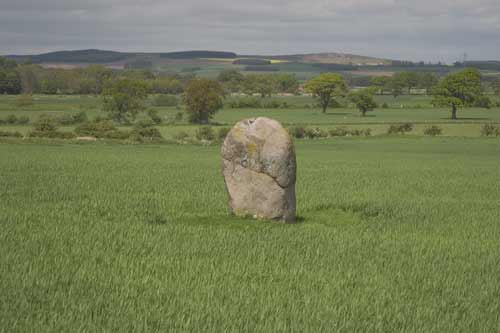
Bendor Stone submitted by kelpie on 16th May 2004. Standing stone found at NT96814 29428. Clearly visible from the road this stone is also known as The Battle stone as it is associated with the Battle of Homildon Hill in 1402, however, the stone itself was likely to have been erected in the Bronze Age.
(View photo, vote or add a comment)
Log Text: The Battle Stone, Bendor: The A697 was busy with holiday traffic today, and with a longish walk ahead of us, we stopped off in a very busy Wooler for refreshments, we headed off towards Kilham and Ring Chesters. As we whizzed along the A697 westwards, I spotted this stone standing in the middle of a field to the north of the road. Husband immediately turned right down the minor road leading to Bendor, a small hamlet just off the road. There was no parking here, just large private forecourts and it seemed the whole village was standing round talking, swinging round to look at us as we turned the car around.
Andrew had spotted a very narrow gateway which sloped down to the gate into the field at NT 96838 29400; this was litter-strewn and not suitable to take the car down. Pulling as far off the road as he could, I took the opportunity to clamber out and walk down to the gate. There was nothing in the field apart from a few curious sheep. Andrew said it was too dangerous to get out of the car, so I did something I wouldn’t normally do and let myself into the field and walked the 20 metres or so to the stone, telling myself if someone noticed me I’d ask permission.
Quickly taking photographs, particularly one with Yeavering Bell in the background (a bit difficult as the light was brightest in that direction and the camera was compensating), I headed back to the car and we turned around ready to resume our journey to Kilham.
St Mary's Motte (Beaumont)
Trip No.40 Entry No.8 Date Added: 25th Aug 2017
Site Type: Misc. Earthwork
Country: England (Cumbria)
Visited: Yes on 20th Aug 2017. My rating: Condition 3 Ambience 4 Access 5
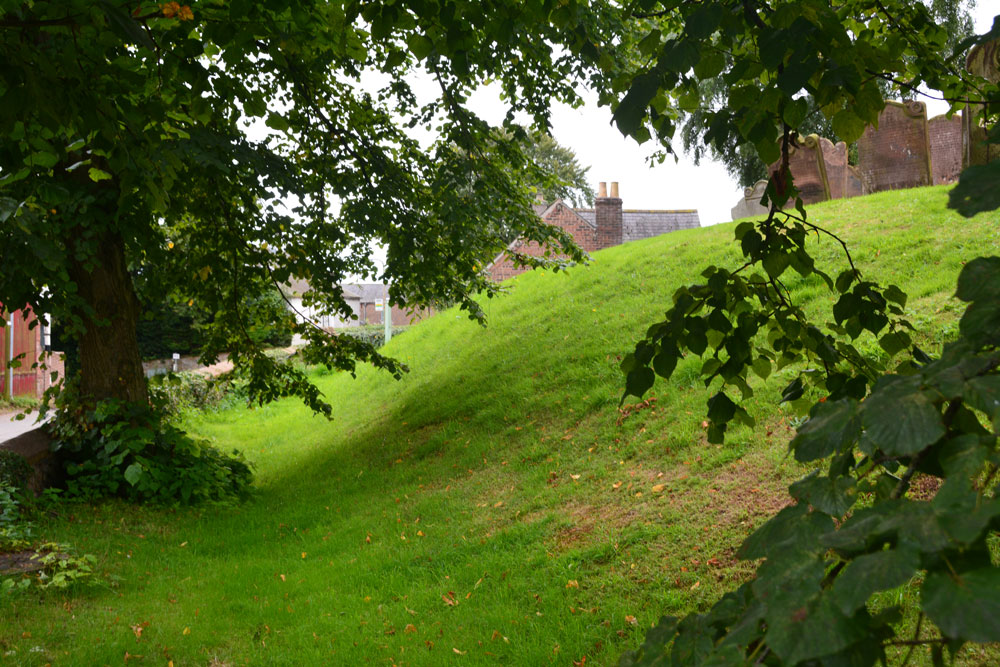
St Mary's Motte (Beaumont) submitted by Anne T on 22nd Aug 2017. Looking at the southern section of the motte, which has been partly cut by the modern road through the village. Pastscape says that the site may originally have been a Saxon or Danish settlement, then the site of turret 70a on Hadrian's Wall, then a Norman motte, finally being replaced by the church in the 12th century.
(View photo, vote or add a comment)
Log Text: St. Mary's Beaumont: Church built on a motte, on a milecastle on a possible Saxon camp: We came to try to see St. Ann’s Well, marked on the OS map as being just off the small triangular village green, but found it was in a private garden surrounded by either a tall hedge or other buildings, so there was no access and no-one around to ask. According to the Old Cumbria Gazetteer, the well is at NY35055942, which is nearer the River Eden, says the well is at NY35055942 (which is different to the OS map) and: “This provided very cold water, useful for helping set the butter. By the time you’d got back up the bank your bucket was only half full.” Dated to 1867 to 1868.
There were lots of walkers trundling along Hadrian’s Wall Path at this point, with a large notice by the interpretation board saying there was a detour due to a large landslip. By this time, my attention had been grabbed by the interpretation board saying this church was built on the line of Hadrian’s Wall and that at one point, a turret (70A) would have stood on the site of the church. The church guide continues: “When the Normans arrived they constructed a motte and baillie as a vantage point to repel invasion from the Scots …. Stones from the wall provided ready building material.”
This is a very pleasant spot. There were so many tractors driving around at this time of the evening we felt out of place! There are farms all along the road through the village. I’d have liked to have seen across to the River Eden, but the farm buildings and houses along its western bank obscured the view. We decided on one final visit, to try and see St. Edward’s Monument (so wet we couldn’t get near last time).
Bride's Well (Stapleton)
Trip No.40 Entry No.5 Date Added: 25th Aug 2017
Site Type: Holy Well or Sacred Spring
Country: England (Cumbria)
Visited: Yes on 20th Aug 2017. My rating: Condition -1 Access 4
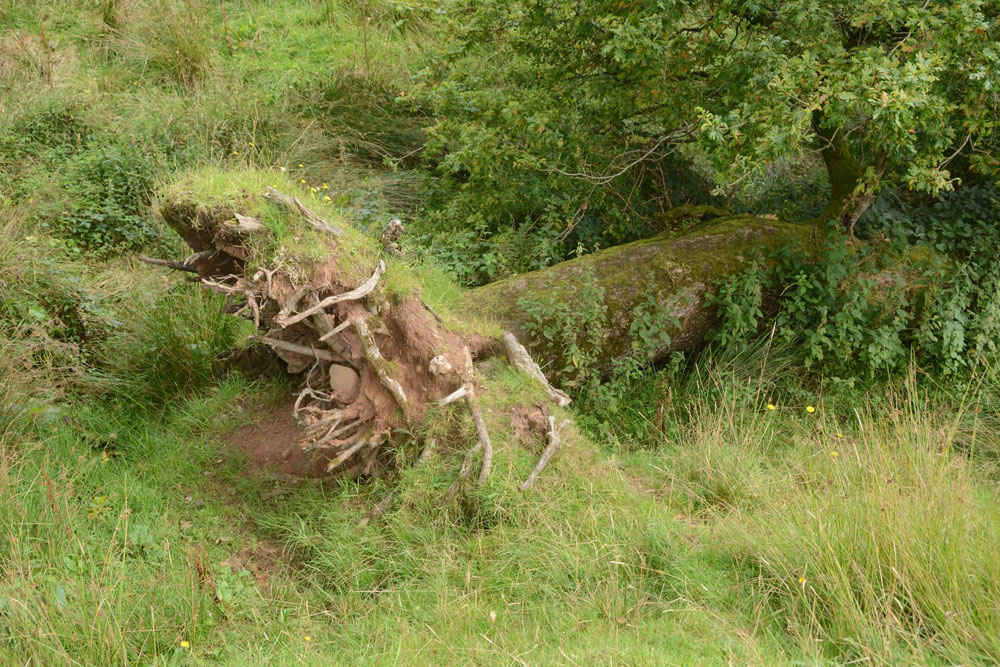
Bride's Well (Stapleton) submitted by Anne T on 25th Aug 2017. This was the fallen tree which lies over the position given for Bride's Well at St Mary's Church in Stapleton, so it may possibly be destroyed. The church warden I contacted thinks the well is in a field behind the vicarage and is going to check and get back to me.
(View photo, vote or add a comment)
Log Text: Bride's Well, Stapleton: Now underneath a fallen tree? Having had to run away from this site to collect our cats from the vets after a very brief search for the well last Thursday, we went back armed with the GPS and OS map and found we’d been looking in the wrong direction.
I’d seen a set of stile leading down to the meadow from the eastern side of the church yard so we found these. They led down to the meadow and the burn running north-south through the field, although they were completely overgrown by nettles. Whilst there were only two small steps on the church yard side, there were around 8 going down into the field below.
We walked round and round and the only feature we could see at the exact grid reference given by Pastscape was this fallen tree. Has the well been destroyed? We had a good look round all along the stream in this field.
I sent an email to the Rector when I got home, and received the reply below. She thinks the well might be in the field behind the rectory, which is above the church, and will check and send an update.
Irthington Mill
Trip No.40 Entry No.4 Date Added: 25th Aug 2017
Site Type: Misc. Earthwork
Country: England (Cumbria)
Visited: Yes on 20th Aug 2017. My rating: Condition 2 Ambience 3 Access 5
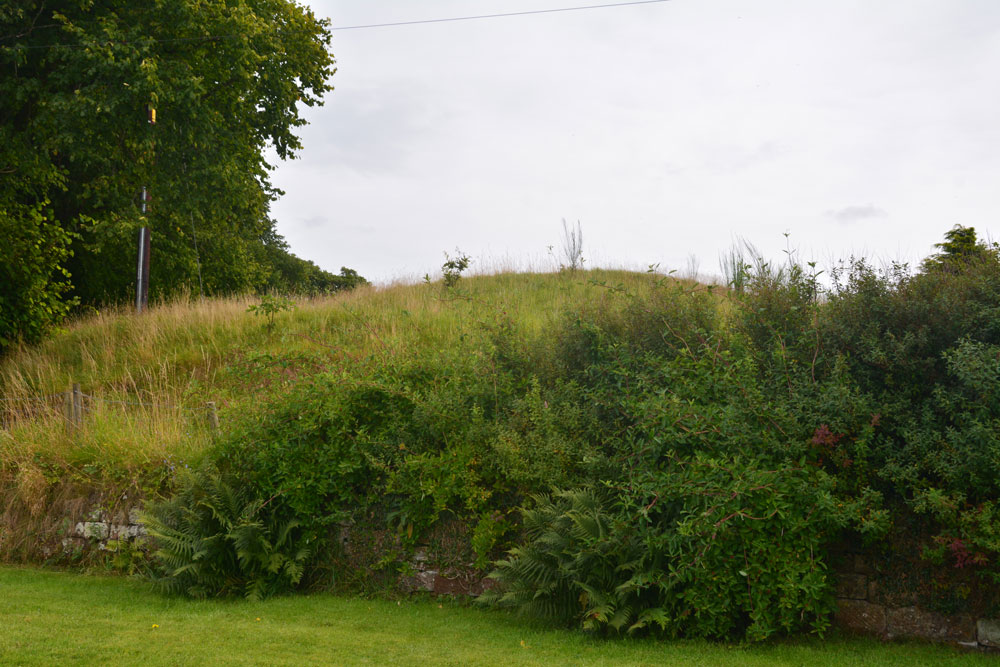
Irthington Mill submitted by Anne T on 25th Aug 2017. The 'motte' from near the driveway to Irthington Mill house. Fancy having part of your garden growing on such an old feature, especially if it is a motte!
(View photo, vote or add a comment)
Log Text: Irthington Mill 'motte or not?': Having spotted two mottes and a holy well just off the road we were travelling on to Carlisle, I asked to take a detour to find these. Whilst this is marked as a motte on the OS map, and certainly looked like one, I got home to find there is some debate about whether this is a motte or a natural feature (it is not recorded on Historic England’s listings).
Situated between a farm with some very old buildings and Irthington Mill house, with part of the Mill’s garden growing up its western slope, and not far from Irthington Bridge, it seemed to me that this motte was in a much more strategic defensible position near the modern day river crossing. Perhaps the course of the river moved over the years and the site of the motte was changed? This is me not wanting to belive its just a natural feature!
Irthington Motte
Trip No.40 Entry No.3 Date Added: 24th Aug 2017
Site Type: Misc. Earthwork
Country: England (Cumbria)
Visited: Yes on 20th Aug 2017. My rating: Condition 2 Ambience 3 Access 5
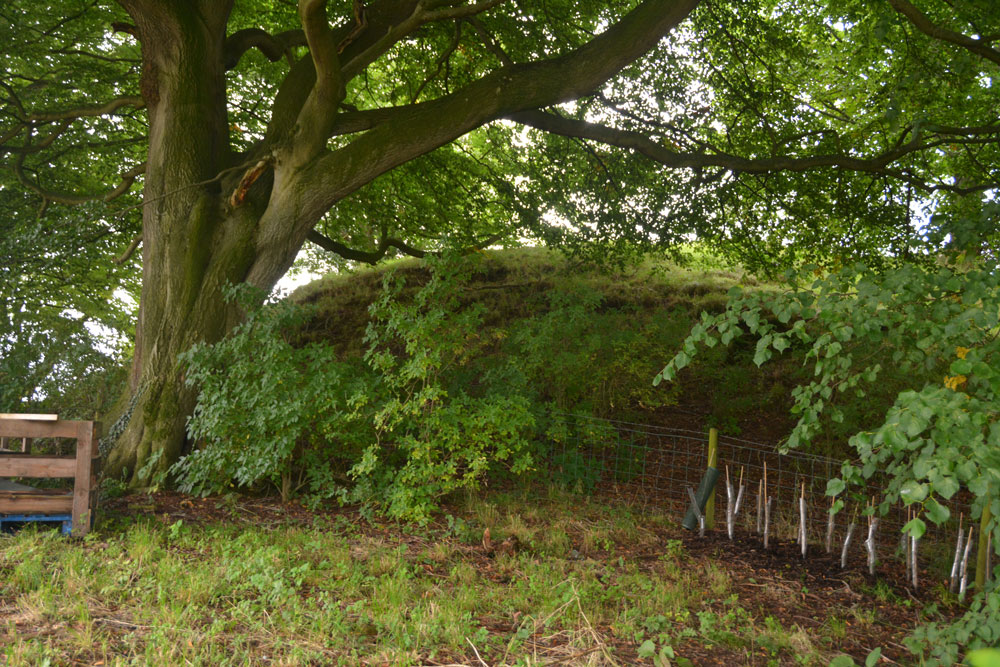
Irthington Motte submitted by Anne T on 24th Aug 2017. Leaning over the fence from the builder's yard, the oval of this earthwork was more obvious. I would have liked to have gone in to the yard for a closer look, but there was a lot of rubble, heavy equipment and a padlocked gate.
(View photo, vote or add a comment)
Log Text: Irthington Motte, Cumbria: We continued walking down the lane which leads to the River Irthing. At first, nothing appeared to stand out as a motte, then I realised that the mound behind the fence, sitting between the farm and the builder’s yard was actually the motte.
Walking down nearer to the entrance to the builder’s yard, the shrubbery was less intrusive and the oval shape of the motte became more apparent.
I would have liked to have gone into the builder’s yard but there was so much rubble, heavy equipment and a padlocked gate. No-one in the farm yard to ask, despite several cars being around.
Hall Well (Irthington)
Trip No.40 Entry No.2 Date Added: 24th Aug 2017
Site Type: Holy Well or Sacred Spring
Country: England (Cumbria)
Visited: Yes on 20th Aug 2017. My rating: Condition 2 Ambience 3 Access 5
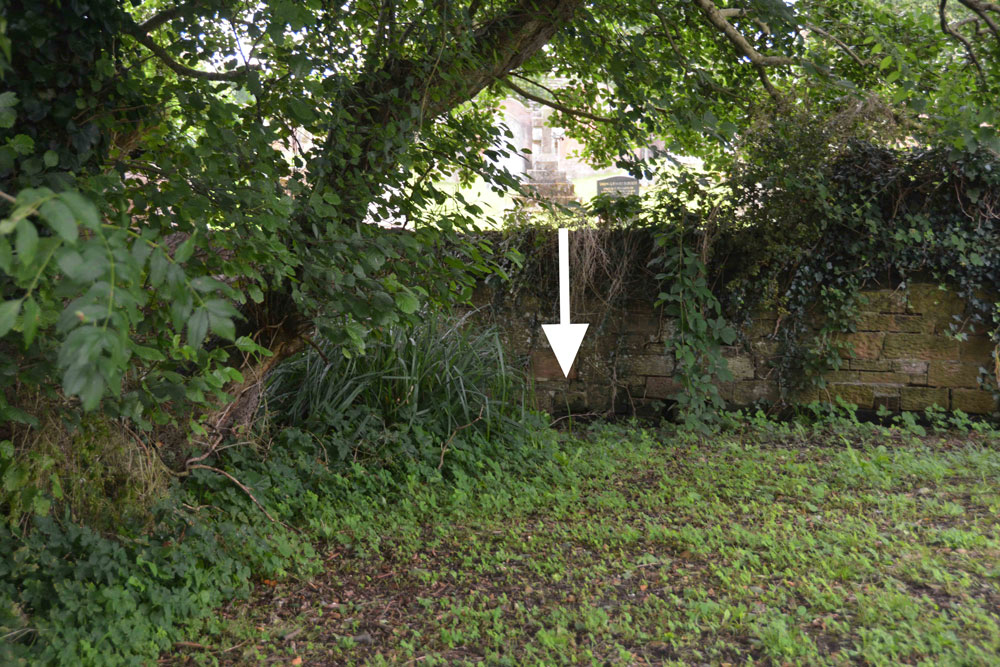
Hall Well (Irthington) submitted by Anne T on 24th Aug 2017. At the southern end of this small grassy area is a boggy area. Just underneath the wooden fence into the neighbouring garden a stream appears from under the bank. This stream has a good flow of water.
(View photo, vote or add a comment)
Log Text: Hall Well, Irthington: From Walton we made our way over to Irthington – not a planned visit, but because I saw the holy well and 2 mottes in close proximity in this village.
This small village (too large to be called a hamlet, but too small to be a good sized village) is obviously old. It’s not that far from Carlisle Airport and stands on the line of Stanegate and is also close to the line of Hadrian’s Wall.
Being armed with the OS map and a GPS, we went in search of the holy well first (passing by the first motte as we’d look for somewhere to park on the way back). According to the OS map the well lies not far outside the south-eastern wall of the church yard. Walking through the churchyard, this area is covered in brambles, nettles and shrubs, but we found some steps leading through the wall and onto the grassy area beyond. At the grid reference above there are some reeds and shrubs sitting in a boggy area. Peering over the fence into the garden of the house sitting immediately to the south, a stream suddenly appears out of the ground and rushes through the garden and is piped under the road, presumably to the modern water pumping station opposite. Nothing exists of any well housing (that we could see) and I’ve emailed the vicar through the ‘A Church Near You’ website.
Just down the road is one of the mottes. Note: the grid reference given by Pastscape indicates the site of the well is around the steps from the churchyard.
